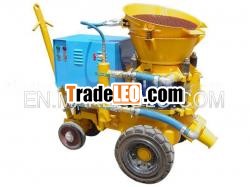Description:
Concrete Gunite Machine1.Output:5.5m3/h
2.Air consumption:7-8m3/min
3.Max. aggregate size:15mm
4.CE certification
RISENPZ-5 Concrete Gunite Machine
Technicaldata:
PZ-5(electricmotor)
Output Capacity: | 5 cubic meter/hour |
Maximum Conveying Distance: | 200 m (660 ft) |
Desired Shotcrete Ingredient Ratio: | Cement/sand and gravel < 0.35 |
Maximum Aggregate Size: | 15 mm (3/5”) |
Inner Diameter of Conveying Hose: | 51 mm (2”) |
Working Compressed Air Pressure: | 29 ~ 87 psi (0.2 ~ 0.6 MPa) |
Conveying Air Consumption: | 250 ~ 285 cfm (7 ~ 8cubic meter / min) |
Ideal Rotor Speed: | 11 rpm |
E-Motor Power: | 5.5kW (7.5 hp), 3-phase |
Dimensions: | 1350 x 750 x 10200 mm |
Net Weight: | 720 Kg |
Application:
- Shotcreting for tunnels, hydro-power engineering, mines,underground engineering, civil engineering and slope stabilization,etc.
- Artificial soil seeding for no soil surface, such as rock,sand, and for no fertility soil surface.
- Refractory spraying and repair for industrial kilns or kilns’inner liner.
Features:
- Non-adhesion going-through rotor with new material chamber,completely eliminate bonding and blocking during operation so as toreduce clearance and maintenance period.
- Thin follow conveying method with vortex flow, so the sprayingflow is even, continuous and steady, to improve the shotcretequality.
- Four-point clamping device make it easy to adjust the pressbetween sealing plate and rotor disk so as to no air and dust leakand prolong consumption parts life.
- Particularly used for dry, damp mix and steel (polymer) fibrereinforced shotcrete.
- Three drive models: by Electric motor, air motor or dieselengine.
- For the most specific risks of this machine, safety andcompliance with the essential requirements of the Directive hasbeen based on elements of EN ISO 12100-1:2003, EN ISO12100-2:2003/A1:1995, EN 60204-1:2006 and EN 1050:1997.
Commonuse:
1. Gunite Swimming Pool Construction.
2. Soil Retention and Tetaining Walls.
3. Rockscaping.
4. Refractory Spraying.
5. Mine Support.
6. Tunnel Linings.
7. Concrete Repair.
8. Artificial Rocks and Caves.
9. Low-volume Refractory Spraying.


